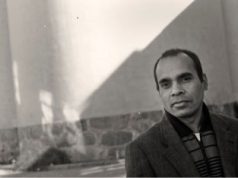 By Dr Indresh Kumar Pandey
By Dr Indresh Kumar Pandey
The ‘Gauchar Mela’, held annually in Chamoli district’s Gauchar grounds, is a key event uniting folk culture and professional activities. Presently established as a state fair, ‘Industrial Development and Cultural Fair, Gauchar’, it traces its origin to 1943, when it began as a small trade fair aimed at promoting local commerce. At that time there was British rule in the country, and the means of market and trade were limited. Owing to its border location, the people of Chamoli shared traditional trade relations with the people of Tibet, resulting in a regular exchange of goods across the frontier. Even before the formal beginning of the Gauchar Mela, Bhotiya traders used to bring shilajit, wool, horses, goats, warm clothes, spices, herbs, musk, jewellery, etc., from Tibet and border areas and sell them in haat markets. Bala Singh Pal, Pansingh Bampal and Govind Singh Rana were prominent traders of the Neeti-Mana valley who made an effort under the leadership of the then social worker and journalist, Govind Prasad Nautiyal, to transform this local market into a fair, a vision that was realised in the year 1943. In the year 1943, this fair was started with the aim of increasing trade between India and Tibet, which was inaugurated by the then Deputy Commissioner of Garhwal, RV Wanirdi.Due to the inaccessible area of the region, this fair was a medium for the local farmers to sell their products and earn money. The fair attracted not only the local farmers but also traders from the Tibet region, who came to sell their indigenous products. But after the India-China war of 1962, trade with Tibet stopped. After this war, Gauchar Mela could not be organised for four years. Following this period, the Gauchar Mela was reinstated through the efforts and initiative of the then government of Uttar Pradesh. This fair, held every year from 14th November to 20th November, has been organised 72 times so far.According to certain literary sources, prior to independence, this fair was held on varying dates; however, after independence, it has consistently been organised from 14th November. Sometimes its date has to be changed due to some special reasons. Due to the municipal elections in the year 2018, the fair was inaugurated nine days later on 23 November.From its inception, the fair has been suspended on ten occasions due to diverse circumstances, including India-China war, the Uttarkashi earthquake, the movement for a separate Uttarakhand state and Covid-19 pandemic. Initially, the fair was primarily attended by the Bhotiya tribe, who brought various goods from Tibet and other border areas to sell, while in return they procured jaggery, herbs and other local products. For these reasons, the fair was referred to as Bhotiya Fair at that time.After the India-China war of 1962, there were major changes in the form of the fair which continue till today. With the participation of state governments, efforts were made to give a comprehensive format to the fair and various dimensions were added to it. In this way, this fair transformed from a pure trade fair into a multi-dimensional trade and cultural fair. During this period, Gauchar Mela came to be known as ‘Gauchar Industrial and Development Exhibition’. In the 1960s, the fair continued to be organised by the Zila Panchayat but after a few years it started being organised by the Municipal Body. From the 1990s, the fair began to be organised by the district administration, which continues till now. From that time the name of the fair was changed to ‘Gauchar Industrial Development and Cultural Fair’. But in the year 2018 and 2019, the fair was organised as ‘Gauchar Festival’. The District Magistrate of Chamoli serves as the Chairman of the Fair, while the Sub-Divisional Magistrate is designated as the Fair Officer. The district administration ensures the participation of public representatives and people working in different sectors of society in the fair through various committees.Along with trade, Gauchar Mela has also been playing the role of carrier of public consciousness. Cultural programmes are presented by various folk artists in this week-long fair. In this way this fair is established as a stage of folk culture and folk life. In ancient times, this fair was an opportunity for people living in inaccessible areas to meet for business and trade.However, at present, it serves as a lively, temporary tourist destination for one week where people from different regions of Uttarakhand gather to enjoy the fair’s entertainment and cultural offerings. Thus Gauchar Mela represents a multidimensional event that embodies a harmonious integration of professionalism, art, entertainment, talent show, tourism and folk culture.
(The Author is Assistant Professor at Government PG College, Karnprayag, Chamoli.)






